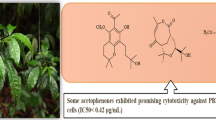Abstract
Prenylated flavonoids represent a unique class of naturally occurring compounds and have proved to be an important source of chemically diverse novel metabolites. Nevertheless, they possess wild array of biological activities. 4′-Methoxy licoflavanone is a prenylated flavonoid isolated from stem bark of Erytherina subrossa. Herein, we report the synthesis of O-alkyl analogs (2a–2m) and 1,2,3 triazole conjugate (3–14) of 4′-methoxy licoflavanone by selective modification at C-7 position in the chromane nucleus. In addition, all the derivatives were evaluated for in vitro antiproliferative activity against a panel of cancer cell lines including pancreatic cancer (Mia PaCa-2), prostate cancer (PC-3), and human leukemia (HL-60) cells. The results revealed that some analogs including 2e and 2m exhibited better cytotoxicity effect than parent compound, specifically on Mia PaCa-2 cell lines.






Similar content being viewed by others
References
Aher NG, Pore VS, Mishra NN, Kumar A, Shukla PK, Sharma A, Bhat MK (2009) Synthesis and antifungal activity of 1,2,3-triazole containing new fluconazole analogues. Bioorg Med Chem Lett 19:759–763
Barron D, Ibrahim RK (1996) Isoprenylated flavonoids-a survey. Phytochemistry 43:921–982
Barron D, Balland C, Possety F, Ravanel P, Desfougeres A (1996) Flavonoïdes prénylés et perméabilité membranaire. Acta Bot Gall 143:509–520
Beutler JA, Hamel E, Vlietinck AJ, Haemers A, Rajan P, Roitman JN, Cardellina JH II, Boyd MR (1998) Structure-activity requirements for flavone cytotoxicity and binding to tubulin. J Med Chem 41:2333–2338
Botta B, Vitalib A, Menendezc P, Misitia D, Monachea GD (2005) Prenylated flavonoids: pharmacology and biotechnology. Curr Med Chem 12:713–739
Brase S, Gil C, Knepper K, Zimmermann V (2005) Organic azides: an exploding diversity of a unique class of compounds. Angew Chem Int Ed 44:5188–5240
Clardy J, Walsh C (2004) Lessons from natural molecules. Nature 432:829–837
Dalvie DK, Kalgutkar AS, Khojasteh-Bakht SC, Obach RS, Donnell JP (2002) Biotransformation reactions of five-membered aromatic heterocyclic rings. Chem Res Toxicol 15:269–299
Epstein RJ (1990) Drug-induced DNA damage and tumor chemosensitivity. J Clin Oncol 8:2062–2084
Jang JP, Na MK, Thuong PT, Njamen D, Mbafor JT, Fomum ZT, Woo ER, Oh WK (2008) Prenylated flavonoids with PTP1B inhibitory activity from the root bark of Erythrina mildbraedii. Chem Pharm Bull 56:85–88
Kolb HC, Finn MG, Sharpless KB (2001) Click chemistry: diverse chemical function from a few good reactions. Angew Chem Int Ed 40:2004–2021
Kumar S, Pathania AS, Saxena AK, Vishwakarma RA, Ali A, Bhushan S (2013) The anticancer potential of flavonoids isolated from the stem bark of Erythrina suberosa through induction of apoptosis and inhibition of STAT signaling pathway in human leukemia HL-60 cells. Chem Biol Interact 205:128–137
Liu Q, Tor Y (2003) Simple conversion of aromatic amines into azides. Org Lett 5:2571–2572
Meldal M, Tornøe CW (2008) Cu-catalyzed azide-alkyne cycloaddition. Chem Rev 108:2952–3015
Miranda CL, Stevens JF, Helmrich A, Henderson MC, Rodriguez RJ, Yang YH, Deinzer ML, Barnes DW, Buhler DR (1999) Antiproliferative and cytotoxic effects of prenylated flavonoids from hops (Humulus lupulus) in human cancer cell lines. Food Chem Toxicol 37:271–285
Mishra BB, Tiwari VK (2011) Natural products: an evolving role in future drug discovery. Eur J Med Chem 46:4769–4807
Taylor RC, Cullen SP, Martin SJ (2008) Apoptosis: controlled demolition at the cellular level. Nat Rev Mol Cell Biol 9:231–241
Thirumurugan P, Matosiuk D, Jozwiak K (2013) Click chemistry for drug development and diverse chemical–biology applications. Chem Rev 113:4905–4979
Acknowledgments
The research leading to these results has received financial support by the Council of Scientific and Industrial Research (CSIR) - India. The authors S. K and A. S. P are thankful to CSIR for providing Senior Research Fellowship. The authors further thank to the analytical department of our institute for providing analytical support.
Author information
Authors and Affiliations
Corresponding author
Rights and permissions
About this article
Cite this article
Kumar, S., Pathania, A.S., Nalli, Y.K. et al. Synthesis of new O-alkyl and alkyne–azide cycloaddition derivatives of 4′-methoxy licoflavanone: a distinct prenylated flavonoids depicting potent cytotoxic activity. Med Chem Res 24, 669–683 (2015). https://doi.org/10.1007/s00044-014-1177-8
Received:
Accepted:
Published:
Issue Date:
DOI: https://doi.org/10.1007/s00044-014-1177-8




